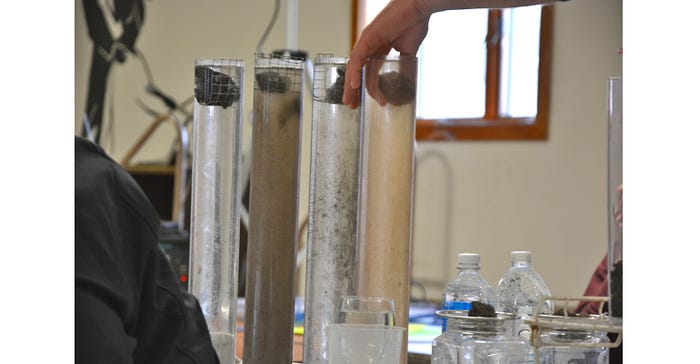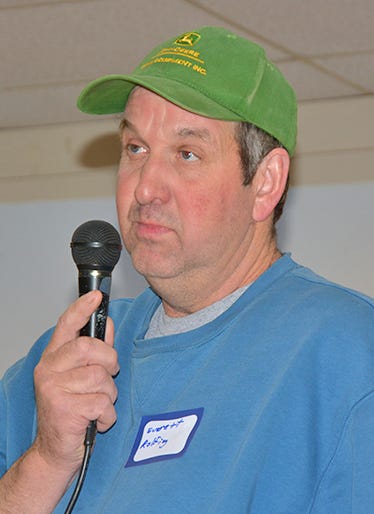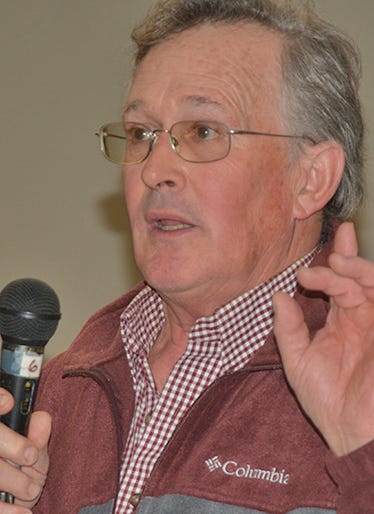
For Ray Archuleta, soil health discussions start with an aggregate slake test demonstration.
At the beginning of a meeting last spring in Lewiston, Minn., Archuleta, known nationally as the “Soil Health Guy,” recruited four volunteers to help. Each was given a different clump of soil — one from his no-till field in Missouri, and three others from conventionally tilled fields in Minnesota, Missouri and Texas. At the same time, they carefully set their soil clods into the top of water tubes fitted with wire baskets.

CHANGING MODERN AG: Using an aggregate slake test, Ray Archuleta demonstrated how healthy soils hold water. The four soils (from left) are a Missouri no-till soil; a Missouri tilled soil; a Rochester, Minn., tilled soil; and a Texas tilled soil. Note the clear water in the tube at far left, which indicates the stability of soil aggregates in no-till soil and how well soil maintains its structure. “This demonstration is changing modern agriculture,” Archuleta said.

The results were quick and dramatic. Tilled soils in the tubes exhibited slaking. They broke up, muddied the water, became suspended or filtered to the tube bottoms. The no-tilled soil clump held its shape, keeping the water relatively clear.
“This is only one indication of soil health and function,” Archuleta said. “Three of the four soils are sick and addicted to high inputs. The soil on the left, I can get on the field two weeks earlier [than conventionally tilled fields] because there is ‘glue’ and structure in the soil.��”
Archuleta was in Minnesota for soil health workshops held in Lewiston, Faribault, Austin and Kasson. They were co-sponsored by the Land Stewardship Project, the University of Minnesota Extension, and soil and water conservation districts in Carver, Dodge, Fillmore, Freeborn, Mower and Rice counties.
Archuleta, who farms near Seymour, Mo., with his family, shared what he has learned over the years about ecology and the connection with soil health. The focus is best placed on farming principles of holism versus reductionism. To explain the latter, he compared agriculture to human medicine. When an individual has a health concern, he says, the U.S. medical system “reduces” him or her and sends the person to a specialist — a heart doctor, a liver doctor, etc. Instead, Archuleta contends, the individual needs a holistic doctor — someone who looks at the whole body.
“I was an agronomist and looked at pieces [of a farm],” he said. “There is a place for reductionism, but not in living systems. You need to look at farms as holistic.”
He encouraged farmers in attendance to walk their grassed waterways and woods.
“You’ll see more aggregation here than in your fields,” he said. “We have reductionist conservation. We’ve got all these practices on fields, and that’s OK — but then you got black open fields.”
Here are a few takeaways from Archuleta’s presentations that day:
Learning curve and economics
“I hear all the time it’s too cold, too dry, too wet to raise cover crops,” he said, “but there is no-till in Canada and Afghanistan … soil has life.”
That said, Archuleta told farmers not to plant cover crops or practice no-till unless they are committed to learning what works for them. Once they do learn, they will see input costs go down. One Minnesota farmer told Archuleta he saw a fuel reduction of 3 gallons per acre when he went to no-till.
“Our job is, after getting corn and soybean out, to cover the soil,” he added.
Cover crop cocktails
Archuleta prefers to work with cover crop cocktails — mixes that he can help tailor for a site.
“Once you bring diversity in, there are 1,700 beneficials for every pest,” he said. “Ten percent of weed seeds are eaten by crickets and beetles. Nature is self-healing, self-regulating and self-organic.”
Accordingly, he is not a fan of seed coatings.
“Seed coatings are killing us. Try buying corn and soybeans without them. It’s tough,” he said. “Slugs eat them, and arthropods eat the slugs and die.”
Farmer panel experiences
At the Lewiston meeting, three farmers with cover crop experience participated in a panel discussion. Sharing their practices were Everett Rolfing, Lewiston, who raises row crops and hay and cover crops, and practices vertical tillage and no-till; Willie Erdmann, Ridgeway, who raises cattle, row crops, hay, small grain and cover crop mixes; and Chuck Henry, Dover, who operates an all-grass organic dairy and raises double-cropped small grains with sorghum-sudan and other forage or cover crop options.

Everett Rolfing

Rolfing said he switched to vertical tillage four years ago on his rolling, steep acreage, and he noted ground mellowing in response to his tillage changes.
“Yields increased, too, due to lots of variables,” he said. Two years ago, he started raising cover crops and saw an instant response — again, ground more mellow than ever. He sows 60 pounds of winter rye following the combine. In the spring, when the rye is about 6 inches tall, Rolfing broadcasts fertilizer, which knocks it down. Later he sprays it, and the rye slowly decays. He plants either corn or soybeans into the rye.
Last fall weather was a problem, so he didn’t get his cover crop seeded. He planned to seed oats last spring and no-till beans into that.
Since seeding cover crops, Rolfing says his crop expenses are way down because of less tillage. “That helps you show a profit with $3 corn,” he said.
Rolfing added that managing cover crops is a constant learning experience. “I do things different every year,” he said, adding he relies on the Natural Resources Conservation Service for information on seeding rates and spraying.

Willie Erdmann

Erdmann started no-tilling and using cover crops about five years ago. On early-harvest wheat and barley, he puts in crimson clover and tillage radish.
“It helps the corn look nice the following year,” he said. Yields average around 200 bushels per acre.

Chuck Henry

Henry milks 200 cows on his grass-based organic dairy farm. He plants multispecies mixes that include clovers, peas and other forages. He manages 600 acres of owned and rented land, rotating cattle every 12 hours onto fresh grass. When it’s hot, he pre-clips pastures before letting cows out so they can graze windrows.
He also makes around 2,500 round bales of silage a year.
“This is like a TMR [total mixed ration] in a bale,” Henry added.
He attributes improved soil organic matter on his farm to having various grass mixes, along with increased cattle numbers over the years. His soil organic matter is around 4.2% to 4.9%.
“It’s all about biology,” he said. “With 115 youngstock [along with the milk cows] — animal impact is the key.”
About the Author(s)
You May Also Like






